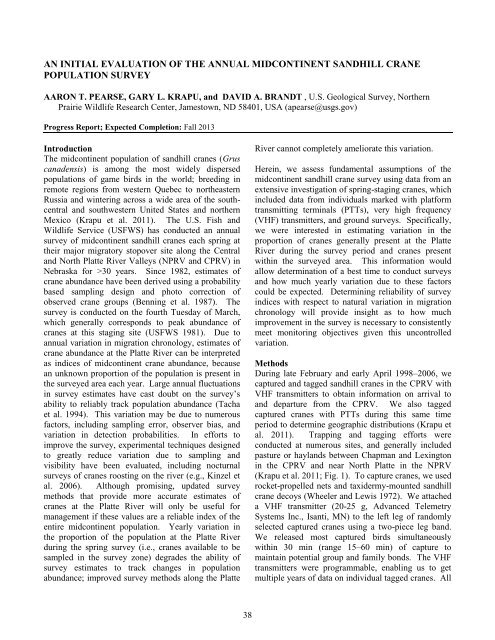Webless Migratory Game Bird Program - U.S. Fish and Wildlife Service
Webless Migratory Game Bird Program - U.S. Fish and Wildlife Service
Webless Migratory Game Bird Program - U.S. Fish and Wildlife Service
You also want an ePaper? Increase the reach of your titles
YUMPU automatically turns print PDFs into web optimized ePapers that Google loves.
AN INITIAL EVALUATION OF THE ANNUAL MIDCONTINENT SANDHILL CRANE<br />
POPULATION SURVEY<br />
AARON T. PEARSE, GARY L. KRAPU, <strong>and</strong> DAVID A. BRANDT , U.S. Geological Survey, Northern<br />
Prairie <strong>Wildlife</strong> Research Center, Jamestown, ND 58401, USA (apearse@usgs.gov)<br />
Progress Report; Expected Completion: Fall 2013<br />
Introduction<br />
The midcontinent population of s<strong>and</strong>hill cranes (Grus<br />
canadensis) is among the most widely dispersed<br />
populations of game birds in the world; breeding in<br />
remote regions from western Quebec to northeastern<br />
Russia <strong>and</strong> wintering across a wide area of the southcentral<br />
<strong>and</strong> southwestern United States <strong>and</strong> northern<br />
Mexico (Krapu et al. 2011). The U.S. <strong>Fish</strong> <strong>and</strong><br />
<strong>Wildlife</strong> <strong>Service</strong> (USFWS) has conducted an annual<br />
survey of midcontinent s<strong>and</strong>hill cranes each spring at<br />
their major migratory stopover site along the Central<br />
<strong>and</strong> North Platte River Valleys (NPRV <strong>and</strong> CPRV) in<br />
Nebraska for >30 years. Since 1982, estimates of<br />
crane abundance have been derived using a probability<br />
based sampling design <strong>and</strong> photo correction of<br />
observed crane groups (Benning et al. 1987). The<br />
survey is conducted on the fourth Tuesday of March,<br />
which generally corresponds to peak abundance of<br />
cranes at this staging site (USFWS 1981). Due to<br />
annual variation in migration chronology, estimates of<br />
crane abundance at the Platte River can be interpreted<br />
as indices of midcontinent crane abundance, because<br />
an unknown proportion of the population is present in<br />
the surveyed area each year. Large annual fluctuations<br />
in survey estimates have cast doubt on the survey’s<br />
ability to reliably track population abundance (Tacha<br />
et al. 1994). This variation may be due to numerous<br />
factors, including sampling error, observer bias, <strong>and</strong><br />
variation in detection probabilities. In efforts to<br />
improve the survey, experimental techniques designed<br />
to greatly reduce variation due to sampling <strong>and</strong><br />
visibility have been evaluated, including nocturnal<br />
surveys of cranes roosting on the river (e.g., Kinzel et<br />
al. 2006). Although promising, updated survey<br />
methods that provide more accurate estimates of<br />
cranes at the Platte River will only be useful for<br />
management if these values are a reliable index of the<br />
entire midcontinent population. Yearly variation in<br />
the proportion of the population at the Platte River<br />
during the spring survey (i.e., cranes available to be<br />
sampled in the survey zone) degrades the ability of<br />
survey estimates to track changes in population<br />
abundance; improved survey methods along the Platte<br />
38<br />
River cannot completely ameliorate this variation.<br />
Herein, we assess fundamental assumptions of the<br />
midcontinent s<strong>and</strong>hill crane survey using data from an<br />
extensive investigation of spring-staging cranes, which<br />
included data from individuals marked with platform<br />
transmitting terminals (PTTs), very high frequency<br />
(VHF) transmitters, <strong>and</strong> ground surveys. Specifically,<br />
we were interested in estimating variation in the<br />
proportion of cranes generally present at the Platte<br />
River during the survey period <strong>and</strong> cranes present<br />
within the surveyed area. This information would<br />
allow determination of a best time to conduct surveys<br />
<strong>and</strong> how much yearly variation due to these factors<br />
could be expected. Determining reliability of survey<br />
indices with respect to natural variation in migration<br />
chronology will provide insight as to how much<br />
improvement in the survey is necessary to consistently<br />
meet monitoring objectives given this uncontrolled<br />
variation.<br />
Methods<br />
During late February <strong>and</strong> early April 1998–2006, we<br />
captured <strong>and</strong> tagged s<strong>and</strong>hill cranes in the CPRV with<br />
VHF transmitters to obtain information on arrival to<br />
<strong>and</strong> departure from the CPRV. We also tagged<br />
captured cranes with PTTs during this same time<br />
period to determine geographic distributions (Krapu et<br />
al. 2011). Trapping <strong>and</strong> tagging efforts were<br />
conducted at numerous sites, <strong>and</strong> generally included<br />
pasture or hayl<strong>and</strong>s between Chapman <strong>and</strong> Lexington<br />
in the CPRV <strong>and</strong> near North Platte in the NPRV<br />
(Krapu et al. 2011; Fig. 1). To capture cranes, we used<br />
rocket-propelled nets <strong>and</strong> taxidermy-mounted s<strong>and</strong>hill<br />
crane decoys (Wheeler <strong>and</strong> Lewis 1972). We attached<br />
a VHF transmitter (20-25 g, Advanced Telemetry<br />
Systems Inc., Isanti, MN) to the left leg of r<strong>and</strong>omly<br />
selected captured cranes using a two-piece leg b<strong>and</strong>.<br />
We released most captured birds simultaneously<br />
within 30 min (range 15–60 min) of capture to<br />
maintain potential group <strong>and</strong> family bonds. The VHF<br />
transmitters were programmable, enabling us to get<br />
multiple years of data on individual tagged cranes. All

















